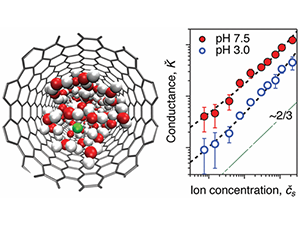Strong Electroosmotic Coupling Dominates Ion Conductance of 1.5 nm Diameter Carbon Nanotube Porins
 ACS Nano 2019, 13, 11, 12851-12859
ACS Nano 2019, 13, 11, 12851-12859
Yun-Chiao Yao, Amir Taqieddin, Mohammad A. Alibakhshi, Meni Wanunu, Narayana R. Aluru, and Aleksandr Noy
The abstract reads as follows: Extreme confinement in nanometer-sized channels can alter fluid and ion transport in significant ways, leading to significant water flow enhancement and unusual ion correlation effects. These effects are especially pronounced in carbon nanotube porins (CNTPs) that combine strong confinement in the inner lumen of carbon nanotubes with the high slip flow enhancement due to smooth hydrophobic pore walls. We have studied ion transport and ion selectivity in 1.5 nm diameter CNTPs embedded in lipid membranes using a single nanopore measurement setup. Our data show that CNTPs are weakly cation selective at pH 7.5 and become nonselective at pH 3.0. Ion conductance of CNTPs exhibits an unusual 2/3 power law scaling with the ion concentration at both neutral and acidic pH values. Coupled Navier–Stokes and Poisson–Nernst–Planck simulations and atomistic molecular dynamics simulations reveal that this scaling originates from strong coupling between water and ion transport in these channels. These effects could result in development of a next generation of biomimetic membranes and carbon nanotube-based electroosmotic pumps.
Ion conductance, ion selectivity studies and MD simulations were supported as part of the Center for Enhanced Nanofluidic Transport (CENT), an Energy Frontier Research Center funded by the U.S. Department of Energy, Office of Science, Basic Energy Sciences under award no. DE-SC0019112.
https://pubs.acs.org/doi/full/10.1021/acsnano.9b05118
